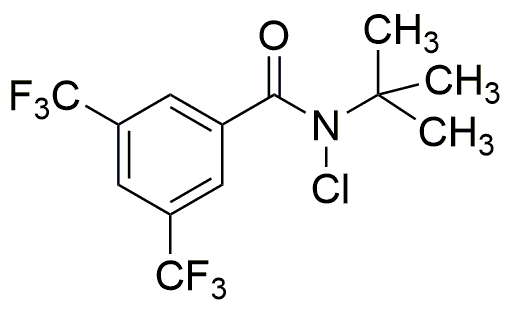N-Chloro-N-(1,1-dimethylethyl)-3,5-bis(trifluoromethyl)-benzamide is widely utilized in research focused on:
- Agricultural Chemistry: This compound serves as a potent herbicide, effectively controlling a variety of weeds while minimizing damage to crops. Its selective action helps farmers maintain healthy yields.
- Pharmaceutical Development: It is explored for its potential in synthesizing new drugs, particularly in targeting specific biological pathways. Researchers appreciate its unique chemical structure for developing innovative therapeutic agents.
- Material Science: The compound is used in creating advanced materials with enhanced thermal and chemical stability. This is particularly beneficial in industries requiring durable and reliable materials.
- Environmental Science: It plays a role in studying the degradation of pollutants, helping researchers understand how to mitigate environmental damage and improve ecological health.
- Fluorinated Compound Research: Its trifluoromethyl groups make it a valuable subject in studies exploring the properties and applications of fluorinated compounds, which are known for their unique reactivity and stability.
General Information
Properties
Safety and Regulations
Applications
N-Chloro-N-(1,1-dimethylethyl)-3,5-bis(trifluoromethyl)-benzamide is widely utilized in research focused on:
- Agricultural Chemistry: This compound serves as a potent herbicide, effectively controlling a variety of weeds while minimizing damage to crops. Its selective action helps farmers maintain healthy yields.
- Pharmaceutical Development: It is explored for its potential in synthesizing new drugs, particularly in targeting specific biological pathways. Researchers appreciate its unique chemical structure for developing innovative therapeutic agents.
- Material Science: The compound is used in creating advanced materials with enhanced thermal and chemical stability. This is particularly beneficial in industries requiring durable and reliable materials.
- Environmental Science: It plays a role in studying the degradation of pollutants, helping researchers understand how to mitigate environmental damage and improve ecological health.
- Fluorinated Compound Research: Its trifluoromethyl groups make it a valuable subject in studies exploring the properties and applications of fluorinated compounds, which are known for their unique reactivity and stability.
Documents
Safety Data Sheets (SDS)
The SDS provides comprehensive safety information on handling, storage, and disposal of the product.
Product Specification (PS)
The PS provides a comprehensive breakdown of the product’s properties, including chemical composition, physical state, purity, and storage requirements. It also details acceptable quality ranges and the product's intended applications.
Certificates of Analysis (COA)
Search for Certificates of Analysis (COA) by entering the products Lot Number. Lot and Batch Numbers can be found on a product’s label following the words ‘Lot’ or ‘Batch’.
Numéro de catalogue
Numéro de lot/série
Certificates Of Origin (COO)
This COO confirms the country where the product was manufactured, and also details the materials and components used in it and whether it is derived from natural, synthetic, or other specific sources. This certificate may be required for customs, trade, and regulatory compliance.
Numéro de catalogue
Numéro de lot/série
Safety Data Sheets (SDS)
The SDS provides comprehensive safety information on handling, storage, and disposal of the product.
DownloadProduct Specification (PS)
The PS provides a comprehensive breakdown of the product’s properties, including chemical composition, physical state, purity, and storage requirements. It also details acceptable quality ranges and the product's intended applications.
DownloadCertificates of Analysis (COA)
Search for Certificates of Analysis (COA) by entering the products Lot Number. Lot and Batch Numbers can be found on a product’s label following the words ‘Lot’ or ‘Batch’.
Numéro de catalogue
Numéro de lot/série
Certificates Of Origin (COO)
This COO confirms the country where the product was manufactured, and also details the materials and components used in it and whether it is derived from natural, synthetic, or other specific sources. This certificate may be required for customs, trade, and regulatory compliance.


